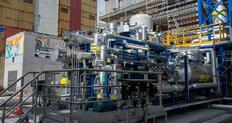- The 24 MW plant at Herøya Industrial Park cuts 41,000 tonnes of CO2 emissions annually.
- Yara signed a CO2 transport and storage agreement with Northern Lights in 2023.
- Yara aims to reduce annual CO2 emissions by 800,000 tons at Yara Sluiskil.
- Yara Clean Ammonia's FY 2023 revenues and EBITDA were USD 1.9 billion and USD 101 million.

Plant Inauguration
Yara International has opened a 24 MW renewable hydrogen plant at Herøya Industrial Park, Norway. The plant, inaugurated by Norwegian Prime Minister Jonas Gahr Støre, is the largest of its kind in Europe. It produces hydrogen through water electrolysis using renewable energy, replacing natural gas and cutting 41,000 tonnes of CO2 emissions annually.
Decarbonization Efforts
The plant's renewable hydrogen and ammonia are used to produce low-carbon footprint fertilizers, contributing to the decarbonization of the food value chain, shipping fuel, and other energy-intensive industries. Yara has already delivered the first tonnes of these fertilizers to Lantmännen.
Future Projects
Yara is also working on producing low-carbon ammonia using carbon capture storage (CCS) to support the hydrogen economy and emerging low-emission ammonia markets. In 2023, Yara signed a binding CO2 transport and storage agreement with Northern Lights, the world's first cross-border CCS agreement in operation. The company aims to reduce its annual CO2 emissions by 800,000 tons at its Yara Sluiskil site and is evaluating large-scale low-carbon ammonia production projects with CCS in the US.
Strategic Goals
Yara emphasizes the urgency of acting on multiple fronts to meet the Paris Agreement goals. The company has reduced its emissions by 45% since 2005 and aims to deliver decarbonized solutions quickly and at scale, leveraging both renewable energy and CCS. This strategy positions Yara to benefit shareholders, customers, employees, and society at large.

